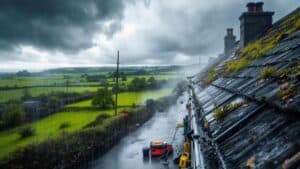Water scarcity is a real and urgent problem in numerous parts of the globe, and it’s vital we come up with creative ways to tackle it. One such method is rainwater harvesting for gardening, a promising strategy for making the most of available water resources in regions where water is in short supply.
By adopting a variety of these water harvesting techniques, folks and communities can access alternative water sources, lessening their dependence on limited city water supplies. But the advantages of water harvesting for gardening aren’t just about saving water.
In this chat, we’re going to talk about the different techniques of water harvesting, look at the benefits it offers for gardening in areas short on water, and point out some successful instances of its use. So, let’s get started on this journey to learn how water harvesting can transform gardening practices and aid in sustainable water usage in regions where water is hard to come by.
Key Takeaways
- Water harvesting for gardening is an effective method for conserving water, particularly in areas with limited water resources, by collecting and utilizing rainwater, thus reducing reliance on municipal water supplies.
- This practice not only aids in environmental preservation by minimizing runoff and pollution but also offers economic advantages by lowering water bills and potentially increasing property value through sustainable infrastructure.
- There are various water harvesting techniques, ranging from simple rain barrels to complex filtration systems, allowing for flexibility and adaptability in different geographic and climatic conditions.
- Successful examples of water harvesting, especially in water-scarce regions, often involve community participation, demonstrating the effectiveness of collective effort in implementing and maintaining these systems.
Water Harvesting Methods
Water harvesting techniques are a brilliant way to cut down on water usage, save precious resources, and lessen the blow of droughts. One popular technique is rainwater collection – simply put, it’s about catching and storing rainwater for future use. This practice helps us lessen our dependence on city water supplies and contributes to preserving water resources.
The rainwater you collect from your roof can be particularly useful for gardening tasks. Consider rooftop gardening, for instance, which is a common way to use collected rainwater. You can install a system of gutters and downspouts to guide the rainwater into storage tanks or barrels. This water can then nourish your rooftop garden, offering a sustainable and self-reliant source of water. Aside from being visually pleasing, rooftop gardens also help combat the effects of drought by minimizing runoff and encouraging rainwater absorption.
There are great examples of rainwater collection for rooftop gardening in places like Melbourne, Australia, and the Bullitt Center in Seattle, USA. These initiatives have shown how efficient rainwater collection systems can be at lowering water usage and preserving resources.
Implementing Water Harvesting Systems
Rainwater harvesting systems are a clever way to collect and save water, particularly in areas where water is scarce. Simple tools like rain barrels, cisterns, and green roofs, along with more sophisticated setups like permeable pavements and advanced filtration systems, can be really cost-effective. They not only lessen the strain on the local water supply but also help save precious water resources and can be a lifesaver during dry spells.
When you’re planning to set up a water harvesting system, it’s important to think about what it’s going to take to keep it up and running. The main parts of the system – the catchment areas, gutters, filtration systems, storage tanks, and distribution systems – all need to be tip-top. Investing in good-quality materials and equipment can make your system last longer and work better.
To keep your system in great shape, you’ll need to carry out regular maintenance. This involves cleaning the catchment areas and gutters so that leaves and other debris don’t block the system. It’s also a good idea to inspect and clean the filtration systems every now and then to make sure they’re working at their best. And don’t forget to check the storage tanks for any leaks and clean them out to prevent sediment from building up.
Benefits of Water Harvesting for Gardening
Gardening with harvested water has a lot of perks! It can help you cut back on your water use, support green living, and even boost your home’s worth. When you start collecting and storing rainwater, you’re not as dependent on the city’s water supply, which can help lower your water bill. This not only helps save water but also provides an extra source for uses that don’t require drinking quality water, reducing the need for costly water infrastructure projects.
Plus, harvesting water helps fight the effects of drought by saving water resources and reducing soil erosion and flooding.
Another great thing about harvesting water for gardening is the positive effect it has on Mother Nature. It cuts down on stormwater runoff and the pollution that comes with it, protecting groundwater resources and natural water bodies. This helps the surrounding area stay sustainable and supports a thriving ecosystem. On top of that, setting up a water harvesting infrastructure can make your property more desirable by showing off your commitment to sustainable water management practices. These practices not only lower the need for water but also reduce the carbon footprint tied to water distribution.
If you live somewhere where water is scarce, harvesting water for your garden is a brilliant solution that offers a ton of benefits for you, your community, and the planet.
Successful Examples of Water Harvesting in Water-Scarce Locations
Curious about whether there are real-world examples of successful water harvesting in places where water is scarce? Absolutely! There are actually a number of cutting-edge methods and community participation initiatives that have demonstrated true success in these water-starved locations.
Take, for instance, the use of rainwater harvesting systems in dry regions. These setups capture and store rainwater from rooftops or other surfaces. The collected water can be used in many ways, such as watering plants. In some scenarios, rainwater harvesting has been paired with other methods like drip irrigation systems to maximise water use and cut down on wastage.
Another effective example is the creation of water harvesting ponds or tanks in communities that have trouble accessing water. These ponds have been developed to catch and store runoff rainwater. When there are dry spells, this stored water can be used for irrigation. This not only aids in water preservation but also gives a dependable water source for gardening and other farming activities.
The role of community involvement cannot be overstated in the success of water harvesting projects. In many scenarios, local communities have taken an active part in the planning, execution, and upkeep of water harvesting systems. This not only makes sure the projects keep going but also fuels a sense of ownership and pride among the people in the community.
Frequently Asked Questions
Where Can Water Be Harvested?
Well, we can tap into a variety of sources! For example, we can use sophisticated processes to extract water from the sea or even unearth it from below the ground. These strategies are especially useful in places where water isn’t readily available, providing a reliable source for watering plants among other uses.
Is Collecting Rainwater Illegal in Ireland?
There aren’t any specific laws against it. In fact, the Water Services Act of 2007 even promotes smart water usage, which includes setting up systems to harvest rainwater. So, you can go ahead and set up your rainwater collection system without worrying about breaking any laws.
What Are the Disadvantages of Rainwater Harvesting?
Collecting rainwater isn’t without its drawbacks, despite its potential as a solution to water shortages for gardening, particularly in regions where water is scarce. Some potential negatives to consider are the risk of water contamination, the considerable initial costs, the amount of space required, and the fact that it depends heavily on the seasons. Additionally, it’s important to remember that maintaining the system may require time and effort.
How Is Water Harvesting Sustainable?
When you harvest water, you’re doing a lot of good things. For starters, you’re less dependent on the city’s water supply. You’re also doing your part to save water, which is a precious resource. Plus, you’re lowering your carbon footprint, and who doesn’t want to do that? And let’s not forget the money you can save.
There are a bunch of ways to make this happen, from using rain barrels to more high-tech water filtration systems. All these methods contribute to a better, more sustainable way of managing our water resources.






